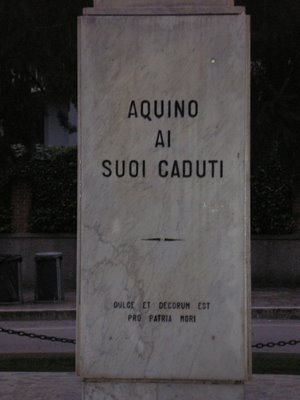Aquinum 2
In the recent post on Aquinum, I forgot to mention that I also saw a nice classical reference in modern-day Aquino in the large piazza in front of the main church in town. On a monument to soldiers fallen in battle one finds the following:
Dulce et decorum est pro patria mori is from Horace Odes 3.2. Here is the text of the whole ode:
Angustam amice pauperiem pati
robustus acri militia puer
condiscat et Parthos ferocis
uexet eques metuendus hasta
uitamque sub diuo et trepidis agat 5
in rebus. Illum ex moenibus hosticis
matrona bellantis tyranni
prospiciens et adulta uirgo
suspiret, eheu, ne rudis agminum
sponsus lacessat regius asperum 10
tactu leonem, quem cruenta
per medias rapit ira caedes.
Dulce et decorum est pro patria mori:
mors et fugacem persequitur uirum
nec parcit inbellis iuuentae
poplitibus timidoue tergo. 15
Virtus, repulsae nescia sordidae,
intaminatis fulget honoribus
nec sumit aut ponit securis
arbitrio popularis aurae. 20
Virtus, recludens inmeritis mori
caelum, negata temptat iter uia
coetusque uolgaris et udam
spernit humum fugiente pinna.
Est et fideli tuta silentio 25
merces: uetabo, qui Cereris sacrum
uolgarit arcanae, sub isdem
sit trabibus fragilemque mecum
soluat phaselon; saepe Diespiter
neglectus incesto addidit integrum, 30
raro antecedentem scelestum
deseruit pede Poena claudo.

